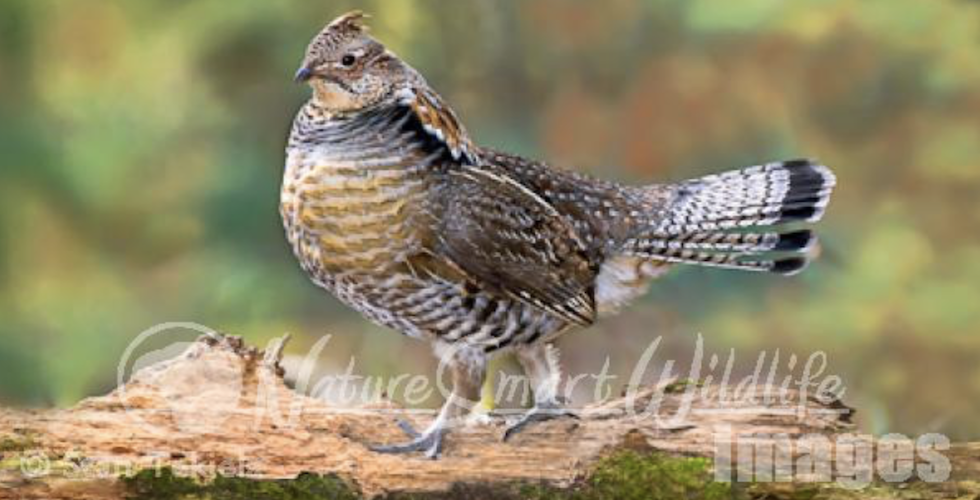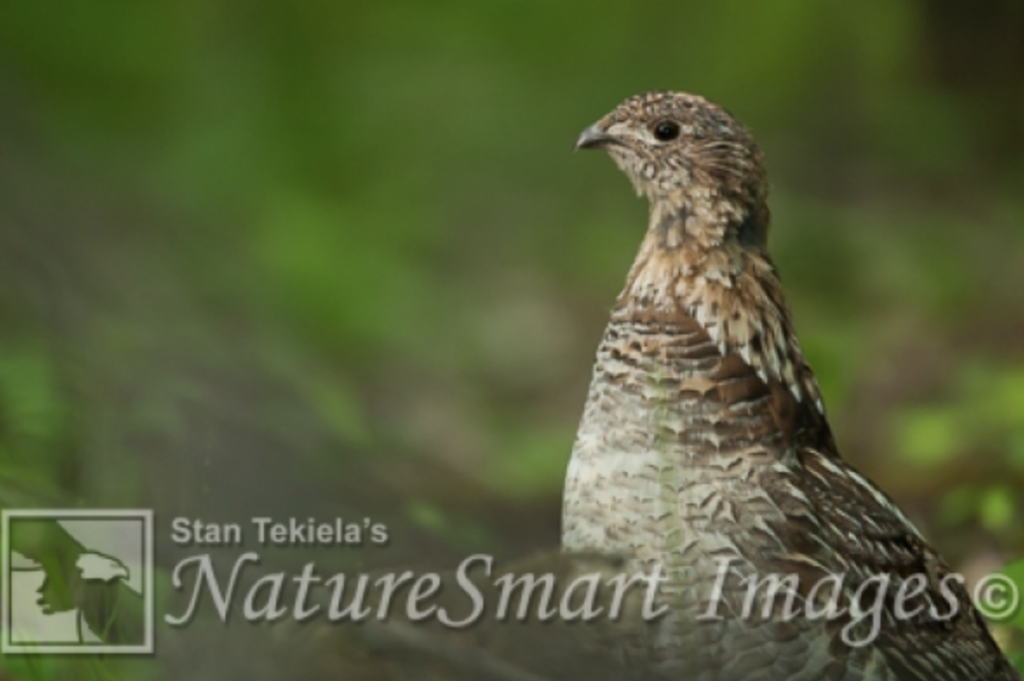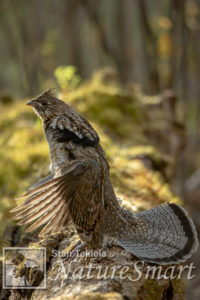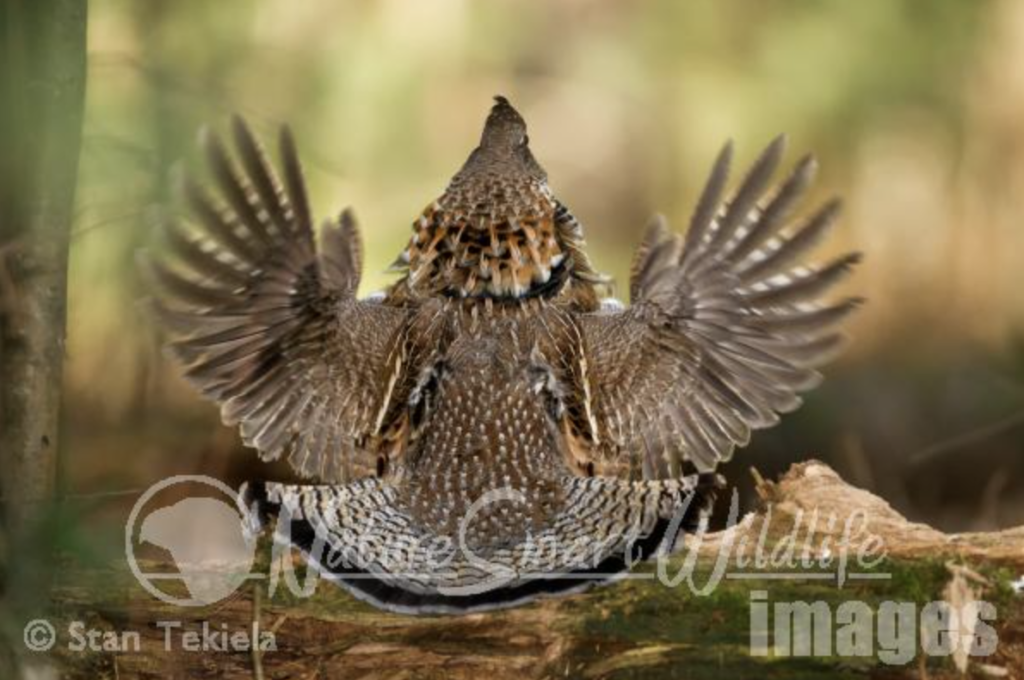
It Takes Patience to Photograph a Ruffed Grouse
Stan Tekiela, naturalist and wildlife photographer, goes through great lengths to bring us pictures of the Ruffed Grouse. Here is his tale.
I am no stranger to getting up at zero dark thirty. But when my alarm goes off at 4 a.m. after not sleeping most of the night, it’s harder and harder to drag myself out of bed. I was reminded of this recently when I needed to get up to photograph a very special bird, the Ruffed Grouse (Bonasa umbellus).

Every year I make an extra effort to locate and try to capture some images of a male Ruffed Grouse drumming on his log. This requires a multi-week endeavor that often results in no images. First, I need to locate some drumming male grouse. This is easier said than done. Ruffed Grouse populations fluctuate up and down over a 10-year period. So, in some years, there are simply not enough grouse for me to find a drumming male.

In the good years, I can often find several males drumming, but that is the easy part. To find them I use my ears. Standing and listening for long periods of time in a big section of woods is the first step. Once I hear the deep, low thudding sound of a male drumming, I move towards the sound in increments of 10 or 20 yards. Then I stop and listen again. I can tell when I’m close when I feel the drumming sound in my chest more than I can hear it in my ears.
Only about 1 in 10 male grouse are drumming in a location that will make good images. So, the search continues. It often takes several days of checking many sections of woods before locating a prospective candidate. Next, finding the male grouse that is calm enough to allow me to set up my blind is extremely hard. I would say only a very select few males are calm enough to allow me to set up.
Next, I need to find a clear “window” or unobstructed view into the drumming log. This is critical; otherwise, I would not be able to capture a clear image of the bird. I also need an open place to set up my blind. Ruffed Grouse habitat is typically a young forest, densely packed with young aspen trees, so finding an open spot is challenging.
After that, I set up my blind and leave it, without me in it, for several days so the male grouse gets use to the new thing in the woods. This is the easy part. I just leave and hope for the best.

Which brings me back to getting up at 4 in the morning and the total lack of sleep that goes along with photographing Ruffed Grouse. I wake in the dark. My sleeping bag is warm and very comfortable, and I really don’t want to get out, but I unzip the bag and roll out. Skipping all normal morning routines, I get dressed; slide into my tall, waterproof boots; and hoist about 30 pounds of camera gear and a tripod onto my shoulder before I head out into the darkness.
The moonlight streams through the woods and lights up the narrow path that leads through the woods towards my blind. Even though it’s well before sunrise, I hear some of the grouse in the area already drumming. Walking as quietly as possible, I make my way to my blind, which is a small (3-foot-square) nylon tent-like structure.

Trying not to make any noise, I get inside and set up my camera. I try to get comfortable on a small and uncomfortable folding camp chair. After settling in, I double-check to make sure I didn’t forget anything like extra camera batteries or memory cards.
It is still dark, and I can hear the woods stirring and coming to life as morning approaches. From behind me I can hear something moving slowly through the dried leaves. Peeking out of the tiny (2-inch) window to my left side, I can make out the faint outline of a Ruffed Grouse walking only 3 feet away from my blind. It’s the male grouse heading for his log. Even though it’s way too dark for my camera to operate, I can see the shadowy figure as he starts to slowly flap his wings. Now it’s a waiting game until I have enough light to capture some images and video clips.
About an hour later, it’s finally light enough and what I see through my camera viewfinder is stunning. The weeks of preparation and getting up in the dark have paid off. I can capture some amazing images of an incredible bird today.
If you enjoyed Stan’s post, you may consider one of his amazing nature books: Majestic Eagles, Wild Birds, or Backyard Birds: Welcomed Guests at our Gardens and Feeders.
You can follow Stan on Facebook and Twitter, or contact him via his web page. Stan’s nationally syndicated NatureSmart Column appears in more than 25 cities spanning 5 states (Minnesota, Wisconsin, Michigan, Illinois, and Pennsylvania) and is circulated to more than 750,000 readers.
For more stories about wildlife and nature, sign up for our newsletter now!


